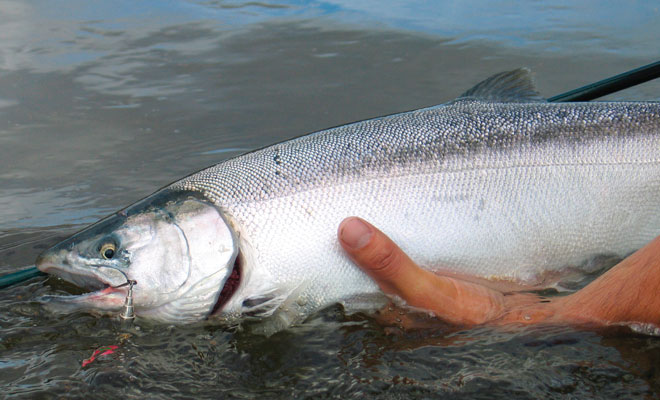
Nushagak Silvers
Story and photos by Marcus Weiner
As I set foot on the shores of the Nushagak for the first time, my impression of the river is more intimate than I expected, as traffic is down to a few boats plying the water for silvers, manning the ADF&G sonar station, or simply traveling from one point to another on the mighty waterway. The hustle and bustle of king salmon season has quieted and most of the camps and lodges on the Nushagak are skeletons of their earlier selves. Make no mistake, there are still plenty of salmon to be caught, as well as grayling, Dolly Varden, and rainbow trout, but you won’t face the throngs of people eager to catch the abundant Chinook for which the river has become famous. Now it is quieter, as the splash of a salmon tail and the flash of chrome signify the return of the coho.
Known for its impressive king salmon run—200,000 in a big year—the Nushagak River is home to all five species of Alaska’s Pacific salmon. In addition, it hosts solid populations of Arctic grayling, Dolly Varden, rainbow trout, and northern pike. Our goal on this trip was to catch silver salmon in the lower river and to travel upriver to a small tributary to catch grayling and trout. An average coho escapement for the Nushagak is an estimated 90,000 fish, providing anglers with ample opportunity to tangle with many a feisty silver. The lowest estimated escapement on record is 20,000 in 1987 and the highest on record is 263,000 in 1982.
The bottom line is that the silver salmon run is highly unpredictable, but biologists have recognized a 4-year cycle on the Nushagak. Luckily for us, 2004 was a high point in the 4-year cycle, and the counting station measured 152,000 fish by the time they closed it for the year on August 16.
Our hosts for this trip are Michael and Angela Addiego of Bristol Bay Adventures (www.bristolbayadventures, 650-637-0260). Their lodge/camp is situated about 30 miles upstream of the river mouth at Portage Creek. It is directly across the river from the ADF&G sonar fish counting station. In talking with Mike, he advised me to come in the middle of August. Silvers begin to show in late July and are finished by the end of August, so the middle of the month was a good window for fish to already have entered the river as well as to intercept silvers fresh from the salt. The 2004 run peaked on August 14, when the sonar counting station estimated that 39,000 fish passed by that day.
On August 9, Wayne Norris and I arrive on a Pen Air flight from Anchorage to Dillingham. Pen Air provides multiple flights per day to and from Dillingham (www.penair.com). Flights are about an hour and a half long. Pen Air also provides service to communities on the Nushagak, and it’s on a small commuter Pen Air flight that we make the final 30-minute flight to Portage Creek. Mike Addiego and Orlando Rocha—one of Bristol Bay Adventures’ guides and an all-around good guy—meet us at the airstrip and ferry us the short distance downstream to camp.
Mike has been guiding in the Bristol Bay area for over ten years and has started small and learned from experience. He realizes that good service makes the difference, so trips are catered to the needs of each client. Mike’s objectives in order are One: Everyone is safe; Two: Have fun; Three: Achieve hunting and fishing priorities. In addition to fully and self-guided fishing trips for salmon and trout, Bristol Bay Adventures offers moose, caribou, and bear hunts. As the season changes to hunting, Mike moves upriver to a base camp with cabins and spike camps for guided hunts. Caribou can be found at the 160-acre lower river camp, but trophy bulls are more readily found upriver.
While the fishing is remote, the camp is luxurious. In addition to six Weatherport tents (15′-18’x 12′), there are two cabins that are each about 1000 square feet. Each can house six people and will be equipped with a kitchen and two bathrooms. The camp has its own bathhouse with a steam room, as well as another large Weatherport that houses the kitchen and dining facility. In addition to having plenty of amenities, the camp is located on prime water on the lower river.
Having stopped in camp and met Angela—an elementary school principal, Mike’s wife, and camp chef extraordinaire—we don our fishing gear and boat across the river to fish. On Wayne’s first cast, he hooks and lands a silver on spinning gear. His lure is a pink #4 Mepps Aglia spinner. He made about a 60-foot cast 45 degrees upstream and was retrieving the lure when the coho struck about 30 feet offshore, slightly downstream of where he stood. We later learn from the people at the ADF&G station that the silvers migrate in good numbers on their side of the river. Migration lanes are an average of 10 to 40 feet offshore. This bodes well for fly anglers fishing from the banks of the river.
We are joined by a guest at the camp, Randy Morris, from northern California. He is here to shoot a caribou—accomplished before we got there this same morning—as well as to catch silvers and pinks. He is an all-tackle fisherman and employs a spinning rod and spinners to fine results. He catches several pinks and silvers during this three-hour session on our first day. I rig up an 8-weight, 4-piece, 9 foot, Lamiglas Jim Teeny signature fly rod with a Ross BG-4 fly reel matched with weight forward floating line. The flies of choice with Mike for pinks and silvers are pink and chartreuse dumbbell-eyed leeches from sizes 2 to 6.
I start with a #6 pink leech and pinch the barb to allow for easier release of the fish. My first three hours yield a half-dozen pinks. They strike aggressively and often and I can see that I’ll need to change the pattern since this pattern is clearly attracting pinks and not silvers. These fish are picking up the fly on the drift and the swing, as well as on the retrieve. I also find that making short, quick strips of the fly through the drift elicits results. All the salmon that we land are bright, with most of the silvers hosting sea lice. An average male is about nine pounds, while an average female is about seven pounds. Mike conveys that the best silver fishing will be on the incoming tides, so we will surely target the two hours before high to intercept inbound fish. We make our final casts and return to camp for lasagna and apple pie.
After eating a big breakfast—it’s obvious I’ll be gaining weight during my stay—we head out again and start across the river. It’s hot and sunny and the fish are spooky. Before heading downriver to try other spots, we stop at the ADF&G station, meet the folks that run it, and get a tour of the facility. From the sonar systems, ADF&G can get precise counts of the number of fish that pass by the counter over an hour’s time. They then make short gill-net sets to sample the fish. From these two sources of data, they can extrapolate salmon escapement numbers by species and migration position in the river.
It’s a tough day of fishing that occurs in spurts. We all catch plenty of pinks, while Wayne lands six silvers, Randy lands five, and I land three. All are taken on spinners. Randy uses several custom creations provided by Mike—typically a silver blade with green or pink beads—and Wayne and I use a combination of Mepps and Luhr-Jensen spinners. We have the most luck on #4 and #5 spinners, with the most productive Mepps Aglia being pink blade/pink beads, gold blade/yellow-red beads, orange blade/ orange beads. The Luhr-Jensen Coho Bolo also worked well—pink and green blade with a green hoochie. For a spinning rod, I’d recommend a medium-heavy, 6 to 8-foot rod, with a quality reel with good drag, matched with 10 to 20-pound line. A similar bait-casting combination would be effective.
Day three begins with good fishing for silvers and pinks. By lunchtime, we decide that the afternoon’s activity will be to fish for rainbows and grayling on the Iowithla River about 14 miles upriver from the lodge/camp. It’s a scenic ride to and from the Iowithla with moose, caribou, osprey, eagle, and fox sightings along the way. We take a johnboat with an outboard and jet out-drive to the fishing location, because the Iowithla is a small tributary of the Nushagak and will present several shallow areas to navigate. We fish for three hours and catch a sampling of rainbows and grayling. There are schools of tomato red sockeye here as well and several aggressively strike our beads as we try to drift behind the school to the waiting resident species. As the sun sets, the no-see-ums descend upon us, and we decide to get back to camp.
Our final morning is spent catching a few more silvers. True to our fish-bum form, we are reluctant to get off the river until the last possible instant. The attack of several silvers within my last five casts helps to make it more difficult to put our rods down. Reluctantly we return to camp and pack up for the flight back to Dillingham. We’ve had a great time with Mike, Orlando, and Angela and have enjoyed success catching coho. Next year it’s either kings from the shore or late fall trout in the upper stretches. Perhaps the call of the mighty Nush will demand both.
Marcus Weiner is a publisher of Fish Alaska magazine.


